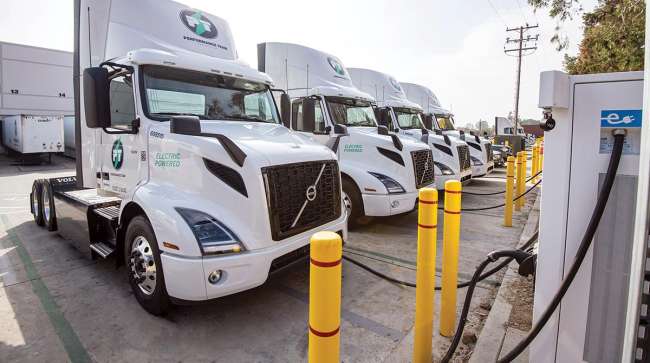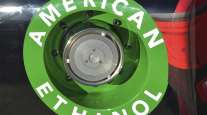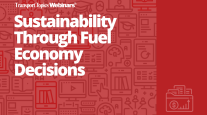Senior Reporter
Trucking Interests Say EPA Is Moving Too Fast on GHG Rule

[Stay on top of transportation news: Get TTNews in your inbox.]
Many of the major players in the trucking industry say they generally are supporters of the goals of the U.S. Environmental Protection Agency’s aggressive Phase 3 proposed rule, but they have concerns that the phase-in is moving too fast.
EPA’s “multipollutant” heavy truck proposed greenhouse gas emissions mandate for model years 2027 and later, first announced in April, will build on existing emissions standards for heavy trucks, ultimately moving toward zero-emission vehicles.
In general, trade associations and large motor carriers say that regulators’ assumptions and timelines are concerning.
“While the stringency requirements proposed in Phase 3 are not specifically directed at trucking fleets, purchasing new trucks will be the key driver of this rule’s expected emissions reductions,” American Trucking Associations said in written comments in mid-June.
President Biden and the @EPA are driving towards a clean transportation future with new proposed vehicle emissions standards for models 2027 and beyond.
These standards would reduce climate pollution, lower costs for families, and reduce dependence on foreign oil. https://t.co/jHc3eVyc98 — The White House (@WhiteHouse) April 12, 2023
“The success of the proposed regulation depends on ZEVs meeting fleets’ need for reliable performance through a vehicle’s useful life with a reasonable return-on-investment,” the federation added.
ATA wrote that fleets remain optimistic about the promise of the technologies, but are facing hurdles with infrastructure delays, high upfront costs and proof of performance, depending on the operation and duty cycle.
“Under the Phase 3 proposal, the EPA will require industry to adopt yet-to-be-proven technology, without sufficient charging or refueling infrastructure to support proposed adoption rates and abandon the collaborative trust by reopening GHG Phase 2 standards,” ATA wrote.
Volvo Group North America agreed.
“Unlike past EPA regulations, where compliance was based on our own investment and effort, this regulation, as drafted, prevents us from being able to ensure our own compliance,” Volvo noted at a recent EPA hearing. “Our customers will not purchase zero-emission trucks unless both the vehicles and the fuels are cost-effective and readily available so as not to negatively impact their business operations.
“Unfortunately, we are starting to see customers delay and even cancel ZEV truck purchases in California because of delayed infrastructure.”
“We will continue to invest in electrification — as well as other zero-emission and alternative energy vehicles — as a key component in meeting our goals of reducing per-mile emissions 60% by 2035,” wrote Schneider. “However, a realistic, balanced and practical approach to emissions reduction is needed.”
Schneider added, “The advent of zero-emission vehicles in the heavy-duty commercial vehicle space is certainly in its infancy and, much like the implementation of any new technology, it comes with obstacles to overcome. Regulations must provide the lead time, stability and certainty that allows for the industry to develop the technology, test in real-world conditions and minimize downtime and operational disruption.”

Guy Broderick of Kriska shares how he successfully combined data reports and a simple understanding of human nature to become one of the best driver coaches in North America. Tune in above or by going to RoadSigns.ttnews.com.
Engine maker Cummins Inc. said that for the commercial vehicle industry, the challenge to achieve zero emissions is significant because of the diversity of applications and customers’ need for new vehicle purchases to have a payback period that supports the success of their business models.
“EPA has proposed the most ambitious heavy-duty GHG standards ever considered, and EPA arrived at its proposed stringencies by projecting almost exclusively a rapid increase in the market adoption of fully electric heavy-duty vehicles in the 2027-2032 time frame,” Cummins wrote.
Cummins said its company and several other stakeholders share concerns about the readiness of the U.S. heavy-duty electric vehicle charging infrastructure to support EPA’s projections in that time frame. “Hybrids are a technology that OEMs and customers can rely on if infrastructure is deemed not ready,” Cummins added.
The Truck and Engine Manufacturers Association had even stronger concerns.
“The NPRM ultimately envisions an almost wholesale transformation of the commercial trucking industry from heavy-duty vehicles powered by fossil-fueled internal combustion engines, to battery-electric vehicles powered and recharged from the nation’s electrical grid, or hydrogen fuel-cell electric vehicles powered by and dependent on an entirely new infrastructure capable of delivering highly compressed or liquefied hydrogen.
“That is a daunting challenge given that, as things stand today, significantly less than 1% of new truck sales are ZEV trucks,” EMA wrote. “The proposed rule also is likely to dislocate tens of thousands of workers and will create heretofore unseen demands for the raw materials, critical minerals and rare earth metals necessary to manufacture the volumes of batteries and fuel cells that will be required to replace the ICEs that have served as the backbone of the nation’s economy for well over 100 years.”
Want more news? Listen to today's daily briefing above or go here for more info
“Any new Phase 3 GHG standards should not take effect until Model Year 2030 at the earliest, to give EPA and truck manufacturers a period of stability to evaluate market conditions and to ensure that a significant step-up in CO2 standard stringency from the current MY 2027 standards is feasible,” wrote Daimler Truck North America.
Natso and the National Association of Convenience Stores urged EPA to adopt a market-oriented, technology-neutral approach to transportation decarbonization.
Remedies exist today to lower emissions without advanced technology. Natso noted, “Increased utilization of renewable fuels could lead to significant emissions reductions by improving the emissions profiles not only of new vehicles but existing vehicles as well. The Proposed Rule surrenders the market’s ability to deliver near-term emissions savings by imposing a top-down, hurried transition to one technology.”
ATA also commented, “EPA’s proposed Phase 3 regulation leaves fleets with the choice of battery electric or hydrogen fuel cell and ignores other readily available low-carbon fuel options using more cost-effective assets.”
Clean Fuels Alliance America spokesman Paul Winters said biodiesel and renewable diesel provide “a solution today that is very clean and offers significant carbon reductions. It’s certainly not as new and shiny as some of the other technologies, but it’s been there, and it’s been proven.”




